Slightly slow (again) this week but we got there in the end. Some unusual cards here this week, and lots of scope for your input.
Time does indeed March on, and here we are in it.
![G075-525 [tobacco : UK] Gallaher “Aeroplanes” (1939) 2/48](/sites/default/files/styles/content_full_width/public/2022-03/spitfire.jpg?itok=RMQM9HqO)
Today in 1936, an aeroplane lifted off on a test flight from Eastleigh Aerodrome in Southampton. It was a very short stint, under ten minutes, late in the afternoon, and the aeroplane was the Vickers-Supermarine Type 300, “Supermarine” coming from the works where it was built.
This aeroplane had specifically been built for the Air Ministry, who had sent out a request for a new single engine interceptor for the RAF. The flight went very well, and the aeroplane started its journey into full production, with hardly any changes, apart from ones which would make it easier to build under more extreme conditions.
Sadly its designer, R. J. Mitchell, never saw his first Mark I, for he had died a year before this “Spitfire” was first flown into a serving RAF base to start its active service, on 4 August 1938. However he was familiar with the name, which had been applied to the earlier prototypes and just kind of stuck.
John Player “Aircraft of the Royal Air Force” (P644-306 – August 1938) 28/50 says it “has been claimed to be the fastest military aeroplane in the World.” though plays it down a bit by adding “Performance figures are not available.” It does give dimensions though, “a wing span of 37 feet and a length of 30 feet.”
W.D. & H.O. Wills “Speed” (W675-222 : W/330A – October 1938) 9/50 tells us once more that “although no exact performance figures can be quoted . . . it is definitely the fastest fighting aeroplane in the World.” And at the end it tacks on a bit of a boast, “the World landplane speed record is at present held by the German Messerschmitt fighter (Card No.10) but a special version of the “Spitfire” may break this record before long.”
Strangely, after all this hiding of facts, Gallaher “Aeroplanes” (G075-525 - 1939) 2/48, tells us that the “famous Spitfire, eight-gun fighter should be claimed to be the fastest military aeroplane in existence . . . capable of speeds well in excess of 360 m.p.h”.
Was this designed to fall into enemy hands and make them shudder? Or was it just a careless slip?
![C505-540 [tobacco : UK] Churchman “In Town Tonight” (May 1938) 25/50](/sites/default/files/styles/content_aligned/public/2022-03/dentist.jpg?itok=47xwekXl)
Today, believe it or not, is National Dentist's Day. Now you might think it is hard to find cards of dentists, but here we have one, by the name of Mr. Sydney A. Kemp F.Z.S. who was featured on Churchman “In Town Tonight” (C505-540 – May 1938). He is not just any dentist though, because if you look at his patient you will see he is a badger; for Mr. Kemp is a Zoo Dentist, on what seems to have been a freelance basis, for it says “He has been called in to render services at the London Zoo and various other private zoos and menageries” and adds that some of his many patients have included bears, kangaroos, chimpanzees, alligators and poisonous snakes. I cannot find any more biographical data about him online though.
There is also another dentist cigarette card – Carreras "Women on War Work" (C151-040 - 1916) 10/50 which states that “ . . . as the Dentists can’t get men to do the necessary mechanical work, they have had to employ women . . . and they will probably be required to continue even after the war.”
A look through early American trade cards will soon bring forth all kinds of medical and dentistry cards, many of the pictures looking rather alarming to our modern eyes. False teeth are also featured on some of these cards, though they had a fall in popularity after a rumour spread that many of the teeth used in the dentures had been removed from American Civil War soldiers who had no further use for them. This is also said to have taken place on the battlefield at Waterloo. The history of dentistry website is a “fun” place to spend some time, and has practically everything you could ever want to know about the subject. It even has a page devoted to dentures – and they were first inserted in a human mouth way earlier than I imagined.
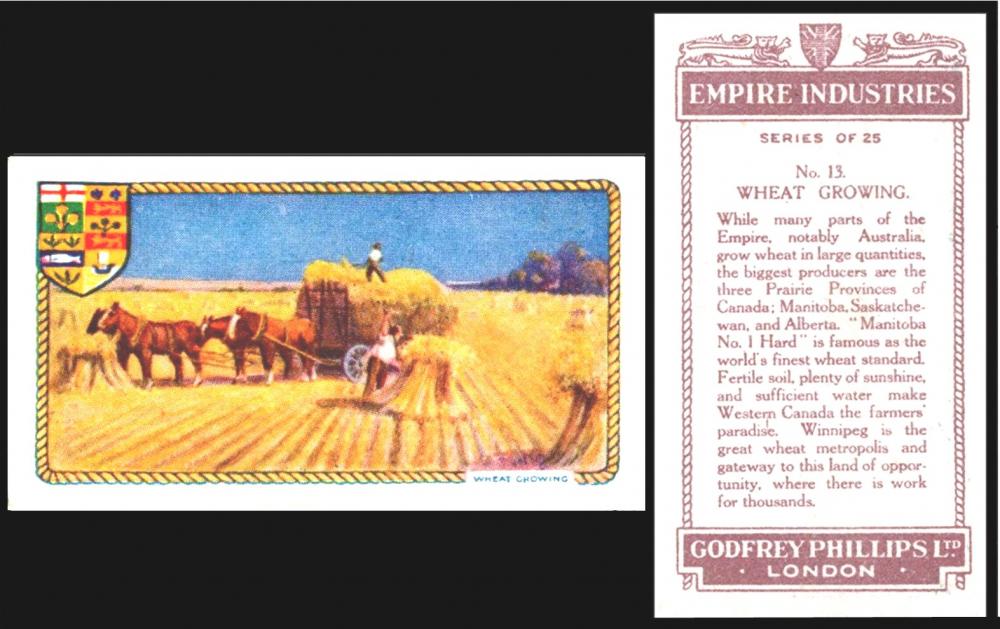
Today is National Cereal Day, and lets start with a word to the young. Before your time, trade cards and plastic novelties/toys were included in with cereal boxes. Sadly these fell foul of the fact that they were fun, but also had a tendency to be a choking hazard.
It was Kellogg's who was first off the bat to ban toys in their packets, way back in 2009, and dare I say breakfasts have never been the same, for all we have now are offers printed on the packets, if anything.
However, there are lots of collectable cards still available online, as well as at fairs and auctions. One site we did discover, sadly no longer going, though I have e-mailed its editor, was/is called boxtop. You can read all the back issues HERE. And I will keep you in the loop as to any reply
There used to be another magazine called “The Crunch” which also dealt with cereal issues. This is sadly no longer in operation, but we hope to be able to bring you a contribution from its editor as well.
The earliest cereal cards I have tracked down were issued by the American Cereal Co. for the 1893 World's Fair, or more correctly The World's Columbian Exposition, because it celebrated the quatercentenary, or four hundredth anniversary of Christopher Columbus reaching America. You can see and read more about these cards at Tradecards.com
![[tobacco : UK] Carreras “Famous Men” (December 1927) 18/25](/sites/default/files/styles/content_aligned/public/2022-03/booth_0.jpg?itok=sfMLNEH-)
Today in 1856 Bramwell Booth was born. You may not know him, but he was the second general of The Salvation Army, and the son of its founder William Booth.
I have not found Bramwell Booth on cards, but his father General William Booth is on Carreras “Famous Men” (December 1927)18/25, one of their “export only” sets, where it tells us that he was born in 1829, but though long a minister and devoted to improving the lives of the souls he saw, he did not actually found the actual Salvation Army until shortly before Christmas 1877, when Bramwell was already 21.
The organisation is still going strong today, across the globe, and right now they have people out there in Ukraine. You can support them at https://www.salvationarmy.org.uk/ where there is a click button for donations
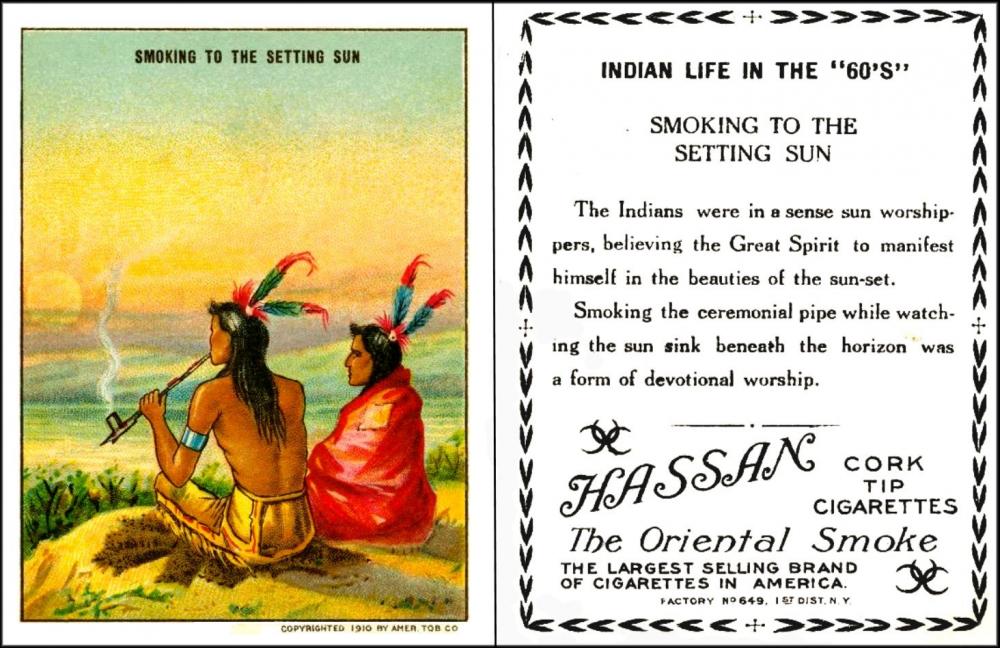
it might seem strange for us to give a mention to No Smoking Day, but the truth is most card collectors do not smoke, we just admire the artistry of our cards, and their educational value, and though we know of their connection, we feel they should not be condemned just because they shared a packet.
As to the theory that they promote cigarette smoking, it is more difficult, because we have woken up to the fact that past misdoings should never be forgotten nor forgiven, and our cards do indeed advertise their wares brazenly, with their entire purpose being that you brought more and more of those named brands in order to be able to complete your set.

until the 13th, Crufts is back at the NEC in Birmingham, and it will be the first show after a covid enforced break.
Man`s Best Friend has featured on so many cards throughout the years that it is hard to pick a favourite, though as in everything, most of us would pick a card that represented our current canine companion, or one we fondly remember, and still miss, from our youth.
We also all have favourite types of dog, which makes me wonder how they pick the winner at Crufts, for any judge cannot help but immediately find themselves drawn towards the sort of dog they like the best.
I do not know the earliest card of a dog, but should imagine it must be either Guinea Gold O75S.DA294, which shows "four bulldogs” or the ten 1902 Tabs cards of Major Richardson`s War Dogs, series D (O/95D), one of which you can see at the Mary Evans Picture Library The first selection of champion dogs, some named, are listed at O/96C, one of those is Cannon Hill Beauty, born in 1896, who was also on a postcard you can see at pinterest. Another is titled as “B.P.`s Maltese Terrier”, an unusual card for a scouting collection as yes, B.P. was Baden Powell, who liked the breed very much. And here is another of the dogs, Belper Snow
our illustration might not win Crufts, but he looks a good companion, someone you could snuggle up to on a cold night and tell all your worries to. And I think that is more important than any prize or award.
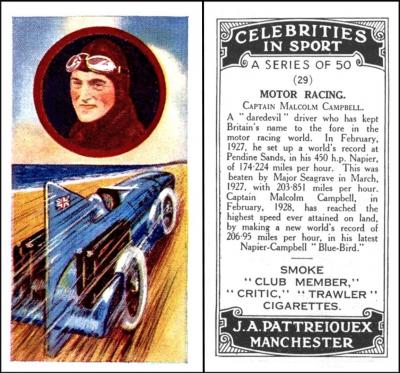
Today in 1885 saw the birth of Malcolm Campbell, in Chislehurst, Kent. He grew up interested in machinery and engines, especially motorbikes, he won several races and in fact he was a despatch rider during the First World War before he joined the Royal Flying Corps.
Before the war he had also raced cars, at Brooklands, in a car which he called Blue Bird, which he himself painted blue.
After the War had ended he was attracted by breaking speed records. In those days this was a common pastime, and car magazines carried lists of records that had not been broken, or that were probably quite easy to beat. Malcolm Campbell set many such records, starting in 1924, and in 1935 he drove the first land vehicle to be recorded at a speed of over 300 miles an hour; this was at Bonneville in America.
Two years later he shifted to the water, setting a speed of almost 142 miles an hour along Coniston Water in the Lake District. He died of a stroke in 1948.
His son Donald Malcolm was also a land and water speed record breaker during the 1950s and 60s, but Coniston Water was not so lucky for him and he was killed there in 1967 whilst trying to raise the water speed record still further.
Cards of Malcolm Campbell include Pattrieiouex “Celebrities in Sport” 29/50, Gallaher “Champions” 32/48, and Ogdens “Champions of 1936” 35/50
This week's Cards of the Day...
... were to draw your attention to World Hearing Day. This event takes place every year on the same day, March the 3rd but I have not been able to find out why that particular day was chosen – the only thing I have found is that an Act of Legislature established The West Virginia Schools for the Deaf and the Blind on March 3, 1870, but this was not the first school in America for the visually nor aurally impaired, and not even the first in Virginia. But I will keep looking.
Hearing loss is often preventable, especially that caused by loud noise from industrial machinery, and music; there is a reason why they say be careful with the volume of those headphones and earphones, though why the makers produce ones with such deafening capability is unclear. And I am not an old fogey, I like my music as loud as anyone, and louder than most, just not inside the tube and right against my eardrum. In fact many famous musicians have found they lose some or most of their hearing in later years.
However one of the many good things about this modern age is that it is very easy to get hearing tests done, and often for free, so if you have such a venue near you, do go along, and get tested. Most of all do not think that being able to hear today is a sign that everything is in good working order underneath the surface, for these tests will pick up any deficiency, and, more importantly, before it has gone too far to be easily fixed.
Our cards this week were :
Saturday, 26th February 2022
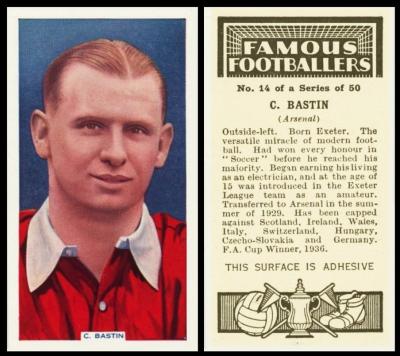
This card shows Clifford Sydney Bastin, and he had a quite amazing career which is well covered by other cards -
R. & J. Hill “Popular Footballers” Season 1934-5, Series A (H554-760.1 - 1935) 4/30 tells us that Clifford Bastin was “Nick-named the “boy wonder” and “at 19 had won every honour the game could offer. His native town, Exeter, actually presented him with his portrait in oils in honour of his prowess”.
In Godfrey Phillips International Caps (P521-454 – 1936) 14/50 he was called “The versatile miracle of modern football”, adding that he “Began earning his living as an electrician, and at the age of 15 was introduced to the Exeter League team as an amateur. Transferred to Arsenal in the summer of 1929” - though Gallaher Sporting Personalities (G075-680 - 1936) 39/48 contradicts the start of that a bit by saying he “..played in a schoolboy international versus Wales at the age of fourteen”.
He remains Arsenal's third-highest goal-scorer of all time, and also played for England.
But why he was here for our card of the day was a reason that was not mentioned on any of these cards, but makes his career even more stunning, for he was growing increasingly deaf, so deaf that he was excused War Service on those grounds and became an ARP Warden instead. You can read all about this at Exeter Memories
This set is unusual, because, as an anonymous issue, it is filed away at the back of our World Tobacco Issues Indexes under the Z numbers. However the listing states
FAMOUS FOOTBALLERS. Sm. 67 x 37. Nd. (50). See RB.13/66.A. Issue by Godfrey Phillips.
They are also listed under the main text of the Godfrey Phillips issues in each book, but with the Z number only.
There is another curiosity about this set too, for it is one of three that use more or less the same pictures but with different set titles. And you can read all about that elsewhere, for one of those was our Card of the Day for February 4th 2023
Sunday, 27th February 2022
![B705-556 [tobacco : OS : Mauritius] British American Tobacco "Figures Historiques" first series "Domino Filter" branded (1961) 11/25](/sites/default/files/styles/content_aligned/public/2022-02/27%20beethovens.jpg?itok=WHO6VUOd)
Here we have a very famous deaf musician, Ludwig van Beethoven.
He was not born deaf, but in his twenties he started to hear strange noises in his head. Some theorists think this was probably a form of tinnitus. However his hearing steadily became worse, until in his late forties he was completely deaf. However he still continued to write music and conduct orchestras even after that.
This is one of the more unusual cards for Beethoven, the usual one that appears for him being the W.D. & H.O. Wills “Musical Celebrities” first series (April 1911 or November 1912) 5/50.
Another scarce card is Godfrey Phillips “Busts of Famous People” (1906/7). This set comes in three versions, hence the “c” suffix, one has a pale green back and black text to the front, one has a brown back and black text to the front, and ours has an olive green back and white text to the front with the addition of a patent number 20736. I am curious as to what this patent is for, but am not sure how to access the patent office records. Another curious thing is that this set has no title, “Busts of Famous People” was only what early cartophilists used to describe it. In addition the chosen title makes no reference to the fact that these cards are actually cutouts; if you look along the edge of the bust, you will see it is perforated to allow the head and socle to stand alone without the blue solid background. Several sets through the ages have been made in this form, though it is an extra process, but what has never been explained is just why this cut-out was done. Any theories out there?
This page is the home page, or link page, for all the sets issued by B.A.T. with the "Domino Filter" branding. There were not many, and all were printed in French, which was the language of Mauritius, where they were issued. Their first set was issued in 1961, too late to appear in our original World Tobacco Issues Index, so they only appear in our updated version, catalogued under British American Tobacco Co. Ltd.`s Section 2, these being "Issues quoting brand names. Series with or without B.A.T. name, inscribed with brand names" and sub section 2J, which covers the issues of "Domino Filter" French language brand issues, without name of firm, in Mauritius, 1960-63. All small size 68 x 37"
It then lists their sets, as :
- ANIMAUX ET REPTILES
- CORSAIRES ET BOUCANIERS (1961)
- FIGURES HISTORIQUES - Une Serie de 25 (1961)
- FIGURES HISTORIQUES - Une Seconde Serie de 25
- FLEURS DE CULTURE
- LES OISEAUX ET L`ART JAPONAISE
- LES PRODUITS DU MONDE
- VOITURES ANTIQUES
The full details of our set in that book are :
FIGURES HISTORIQUES (Historical Personages). Sm. Nd.
1. "Une Serie de 25" (25)
2. "Une Seconde Serie de 25" Nd. 1-25. (25)
And though I found other sets by this issuer in the Cartophilic World magazine, I did not find this one.
Monday, 28th February 2022
![M884-450 : M142-33 [tobacco : UK] B. Morris "How to Sketch" (1929) 29/50](/sites/default/files/styles/content_aligned/public/2022-02/28%20ears.jpg?itok=lEM3J_8a)
in case you were still baffled by our clues, our last one was an ear, which is the organ affected by deafness.
It seems a strange thing to me that anyone would want to draw an ear at all, (unless that is where your particular fetish lies…), let alone spend any time labouring over the correct shading etc.
However an awful lot of work has gone into this text, researching the ear and all of its measurements, and the card is able to inform us that our ears are as long as our noses, and run parallel to them. In addition that the ear is half its own length at the widest point. And furthermore, if it is divided into three equal parts, the middle division will be the size of its orifice (or lug-hole).
Now I am sure you are all itching to go and fetch a ruler and check all of this out for yourself, and if so, do report if the card is right...! And after that feel free to go out and make your friends check their ears as well...
Tuesday, 1st March 2022
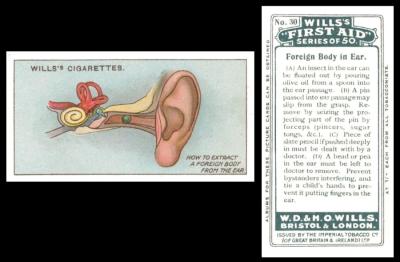
Did you notice that the front of this card is titled “How to extract a foreign body from the ear” but the reverse just says “Foreign Body in Ear”? It is not unusual for the front and back title of a card to differ, though for the most part it is a simple case that a long title would fit quite well on the plain part of the front of a horizontal card, but take up too much room on the reverse.
Getting objects inside of the ear is one of the big causes of deafness, but for the most part the trouble is not because of it going in; for the worst damage happens when trying to get it out by poking something else in that has no business being there at all. And, as you can see on this card, the ear is one of the most complex organs in the body, with a very delicately stretched drum and all manner of coils and springs behind it.
Apparently, according to a recent survey, the most usual things to be “lost” inside an ear are pebbles, beans/peas (like on the card), cotton swabs or parts thereof (this is more common than you might imagine), or coins (which I seriously cannot believe this !). But the largest problem of all are insects, which either fall in, or creep in whilst we are sleeping, or fly in whilst we are working in the garden.
There are two versions of this card, which is noted in our original reference book to the issues of W.D. & H.O. Wills. And both appear in our gallery, so click the bold link below to compare them. The text in that book reads :
61. FIRST AID. Fronts lithographed in colour; backs in grey, with descriptive text. Home issues :-
A. Without Album Clause. Issued, 1913.
B. With Album Clause. Issued, 1915.
The Album Clause in this case means the wording which appears down both sides of the reverse text.
We also know the months of issue, April 1913 for "without" and January 1915 for the "with". That seems to be at odds with our World Tobacco Issues Indexes though, as both the original and the updated version gives the "A" suffix to the cards with the album clause and the “B” to the cards without.
Wednesday, 2nd March 2022
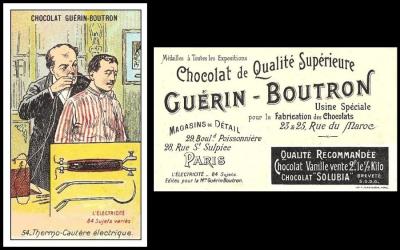
This card shows that the uses of electricity can often be wonderful, for here we have it pressed into the service of man, or pressed into his ear, anyway.
This is thermo-cautery, or electro-cautery, which, in its most basic form, is simply a heated metal wire, which can both destroy unwanted and diseased tissue, and stop bleeding, depending on the pattern of waveforms used. And it is still very much used today, inside ears, as shown here, as well as down throats, into eyes, and underneath the skin, as well as in plastic surgery, especially on visible parts where any temporary colouring imparted by the thin wire will be less obvious than a scalpel. It also has one major advantage, for any current generated does not pass through the body of the patient, so it is safe for those with pacemakers and other internal machinery.
Now you may be thinking that this is a newly invented thing - but it is not. The electrification may be recent, or recent-ish, but the cautery was first written of by Hippocrates in 500 B.C., and, even more astonishingly, he recorded that it was used to destroy tissue lesions. We also have evidence that it was used in prehistoric times, by thin traces that have been spotted on early skulls and bones. As to what they used for the heating, it looks like it would have just been a fire, in a bowl or hearth, and the wires would have been stuck inside it until they glowed white, and were ready for use.
You may also be wondering how you could sustain the uses of electricity over eighty four cards. Actually this is a fascinating set, and quite easy to acquire as odds - though I had a lot of help from several collectors who sent in their lists, and, pleasingly, many of these were incomplete, so we all helped each other. It was more difficult to work out how to list them, but we have come up with using what is actually written on the card as the first part of the description (which is in French), and then typing in a translation, italicized, in square brackets.
Therefore the full list of this set, save two cards,(15 and 19) is :
- 1. La grenouille de Galvani [Galvani`s frog]
- 2. La bouteille de Leyde [the Leyden jar]
- 3. La Pile de Volta [the voltaic pile]
- 4. Machine Electrostatique - La grele artificielle [Electrostatic machine for making artificial hail]
- 5. Pile secondaire de Planté 1ere forme des accumulateurs [secondary battery of Gaston Plante]
- 6. Pile au bicarbonate pour petits éclairages [bicarbonate battery for small lights]
- 7. Pile Leclanché à vase poreux pour sonneries [Leclanche`s porous vessel battery]
- 8. Bobine de Ruhmkorff - Pistolet de Volta [Ruhmkorff`s coils - Volta`s pistol]
- 9. Tubes tournants de Geissler [Geissler tubes]
- 10. Batteries d'accumulateurs [Accumulator battery]
- 11. Groupe électrogène à vapeur[steam generator]
- 12. Batteries de dynamos actionnées par des turbines [Dynamo batteries powered by turbines]
- 13. Installation d'une ligne aérienne [installation of an overhead line]
- 14. Station centrale tableaux de distributions [Central electricity station distribution boards]
- 15. Tramway a Trolley [trolleybus]
- 16. Atelier Mobile pour les lignes de Tramways [mobile tramway line repairer]
- 17. Tramway a Plots [studded tramway]
- 18. Tramway à Caniveau [tramway with central gutter?]
- 19.
- 20. Locomotive Thomson Houston [Thomson Houston electric locomotive]
- 21. Landau Electrique [electric limousine]
- 22. Machine Magnéto-Electrique pour l`Allumage des Moteurs d`Autos [Magneto-Electric Machine for Ignition of Car Engines]
- 23. Pompe a incendie, mue par p`electricitie [Fire Engine powered by electricity]
- 24. Ascenseur Electrique [electric lift]
- 25. Monte-Charge Electrique [electric hoist]
- 26. Tour Electrique [electric lathe]
- 27. Perforatrice rotative électrique des Tunnels [electric tunneller for mines etc]
- 28. Perçage du verre [drilling holes in glass]
- 29. Perceuse de métaux portative et ajustable [Portable, adjustable, metal drill]
- 30. Treuil Electrique [electric winch]
- 31. Le Labourage Electrique [electric tractor]
- 32. Cabestan électrique des gares [electric station capstan]
- 33. Presse à Imprimer mûe électriquement [electric printing press]
- 34. La lampe a arc [arc light]
- 35. Fleurs lumineuses d'illuminations [lighted luminous flowers]
- 36. Fontaines lumineuses [illuminated fountains]
- 37. Lampe à vapeur de mercure [mercury vapour lamp]
- 38. Premiere Locomotive Electrique 1879 [first electric locomotive, 1879]
- 39. Signaux optiques militaires [military electric signalling lamp]
- 40. Projecteur de marine [electric marine searchlight]
- 41. Phare électrique a éclipse 1er ordre [lighthouse with flashing electric lamp]
- 42. Allume-cigare [electric cigarette lighter]
- 43. Eclairage Eectrique pour Danses Serpentines [stage lighting effects]
- 44. Cinematographe [film projector]
- 45. Four à diamants artificiels [Making artificial diamonds]
- 46. La cuisine electrique [electric cooker]
- 47. Radiateur Electrique [electric radiator]
- 48. Fer a Souder Electrique [electric soldering iron]
- 49. Appareil à fondre la cire sans danger d` incendie [fire-proof wax melter]
- 50. Balayeuse Electrique [electric street sweeper]
- 51. Application des rayons X à la douane [X-rays at customs]
- 52. Lampe pour la laryngoscopie [lamp for laryngoscopy]
- 53.Tannage des Cuirs à l'Electricité [Electric tanning of leather]
- 54. Thermo-cautere electrique [Electro-cautery]
- 55. Appareil pour transmettre les images à distance [distance transmitter for images]
- 56. Laboratoire de Mesures et Recherches [research and development laboratory]
- 57. Thermomètre avertisseur de minima [minimun temperature thermometer]
- 58. Reveille-Matin Electrique [electric alarm clock]
- 59. Electrocution [The electric chair]
- 60. Brosse à parquets, mue par l`electricitie [Electric floor brush]
- 61. Galvano à la pile [Galvano`s battery]
- 62. Galvano à la Cuve [Galvano at his tank]
- 63. Electrolyseur pour le Blanchiment des Toiles et Papiers [Electrolyser for Bleaching Fabrics,and papers]
- 64. Riveuse électrique mobile [Mobile electric riveter]
- 65. Telegraphie Morse [Morse telegraph]
- 66. Telegraphe Breguet [Breguet`s telegraph]
- 67. Télégraphie sans fil [wireless telegraph]
- 68. Telephone bureau centrale [switchboard]
- 69. Telephone sans fil système maiche 1906 [cordless telephone from 1906]
- 70. Torpilles electrique [electric torpedoes]
- 71. Tirages des Coups de Mines à distance [remote mine blasting]
- 72. Chasse-Neige mû par l'Electricité [Electric snowplough]
- 73. Appareils moteurs des sous-marins [submarine engines]
- 74. Triage des minerais par l`électro-aimant [Ore sorting by electromagnet]
- 75. Pile thermo-électrique de Melloni [Melloni`s thermo-electric battery]
- 76. Ventilateur de mines [mine ventilation]
- 77. Télégraphe Imprimant de Baudot [Baudot's Telegraph Printer]
- 78. Haut-fourneau electrique [Electric blast furnace]
- 79. Tracteur électrique des mines [electric mining tractor]
- 80. Meule électrique mobile [mobile electric grinder]
- 81. Escalier Mobile Electrique [escalator]
- 82. Pont roulant électrique [electric overhead crane]
- 83. Appareil portatif d'électrothérapie [portable electrotherapy machine]
- 84. Enlevage des rails par l`électro-aimant [lifting rails by electromagnet]
Now the card which helps us most to date this is card 69, which gives a date of 1906.
Thursday, 3rd March 2022
![BRM-51 [trade : UK : tea] Brooke Bond "Inventors & Inventions" (1975) 41/50](/sites/default/files/styles/content_aligned/public/2022-03/03%20hearing%20aid.jpg?itok=fj6iie7A)
This seems to be the only card ever issued that shows a Hearing Aid, though the text tells us that this device was a development of the long known fact that sound can be heard better by cupping a hand to an ear. That led to using animal horns to magnify the sound, and, luckily for the animals, to a better way, manufactured by man, and called the ear trumpet, a device that looked rather like a gramophone horn.
The card tells us that there was “no electronic device of any use appeared until the Marconi Company produced the valve operated Otophone in 1923”. This was bulky and weighty, at 16lb. The important word there is "electronic", for hearing aids had been around for almost a hundred years, and a spot of research finds that the otaphone, sometimes spelled otophone, was already a word in use to describe a hearing aid, the first ever to be patented, in March 1836, to an ear specialist Alphonso William Webster.
You can see this, and read more, at a fascinating site called Nineteenth-Century Disability
The link at the bottom of that page takes you to another site at the Washington University School of Medicine which shows other concealed hearing devices. It is well worth the trip, and more time can be spent using the links on the left hand side-tab
As for our card, it comes from a very interesting set that traces the story of invention from the wheel up to a glimpse into the future, with a miniature television, shaving cream that dissolves whiskers, and spaceships that travel faster than the speed of light.
They claimed that these would be reality in a century`s time (by 2075), but the first of these was already a reality - for in 1970 Panasonic had started to retail a pocket sized television, and Sinclair soon brought out a rival. Whilst the shaving cream that dissolves whiskers simply sounds like the sort of waxes that ladies have used for many centuries, right back to the time of Ancient Egypt. However travelling at the speed of light (299,792,458 metres per second) has not yet been attained, and probably never will be - though we must remember that until 1947 it was thought impossible to break the sound barrier.
Note that we only have one reference code, because as this set is post 1970, it does not appear in our updated British Trade Index. The code we use comes from our vintage volume, RB31, the British Trade Index Part III, which was published in 1986. The text is also a bit sparse, for even the measurements appear in the header (68 x 37), it just reads :
INVENTORS AND INVENTIONS. Nd. (50). Issued 1975 ... BRM-51
There was a special album, which cost 8d. and a wallchart. Do note that there are two different versions of the order form. The original was stapled in to the album as the centre spread, but there is a second which was obtained from Brooke Bond, maybe even returned with your order of missing odds. Both, confusingly, are printed in red - so the best way to tell them apart is by the staple marks at the fold, because the second version was never inserted into an album. And often, but not always, the second version has a number on the back so that Brooke Bond could tell if you ordered more odds or sets at a later date.
Friday, 4th March 2022
![O100-412 [tobacco : UK] Ogden “Boy Scouts” fifth series of 25 cards (September 1914), card number 213](/sites/default/files/styles/content_aligned/public/2022-03/sign%20language.jpg?itok=u2cf8zXw)
This is the first card in a series which spreads over four cards and gives what it calls the basic alphabet for the Deaf and Dumb. You can now see all the cards, front and back, at the bottom of this section.
We know this today as sign language, and it is, as it says, a way of converting the alphabet, and some common phrases into a sign or symbol that is universally known. In this country it is often called British Sign Language, or BSL for short, and it is actually recognised as an official language. Something you may not know though is that just like any language it has regional variations, and the signs can also be different in other countries.
You may think it is very far sighted of the scouts to include sign language in their lives, but it also had a more secretive use, more along the lines of codes and ciphers, that could be used to pass messages and comments under the noses of non-scouts.
As for when sign language began, the earliest recorded reference to a system that enabled people to express their feelings by making signs comes in the 5th century BC - however it suggests that it was already in common usage by those who could not speak. You can read the entire fascinating story of sign language at Wikipedia/SignLanguages - and I would also like to mention sense.uk
Even more amazingly, I know of no other cards showing sign language in the whole of cartophily. If you do, please let us know.
Rather a tale to tell here about the "Boy Scouts" grouping, but the home page for that is with our Card of the Day for the 27th of July, 2022. This will soon contain the listing of all the sets and the links out to the constituent parts, where just the relevant section of that one group will appear.
This set, the fifth, was only issued by Ogdens, and there are, unusually, only twenty-five cards, rather than the usual fifty. It is first recorded in our original Ogdens Reference book (RB.15), which was published in 1949, as
44. 5th Series. 25 subjects. Numbered 201-225. Backs in green. Issued 1914.
It was actually issued in September 1914, which could well be why it only had twenty-five cards; perhaps the arrival of the war changed everything, and they just printed the artwork which had been done so far, desperate to get the information out there quickly to all the boys who would be affected by the war, or become part of it. Maybe other parts were also planned, but cancelled. We will never know
Anyway here are all four fronts. And if you do know of any other cards featuring sign language, please let me know.
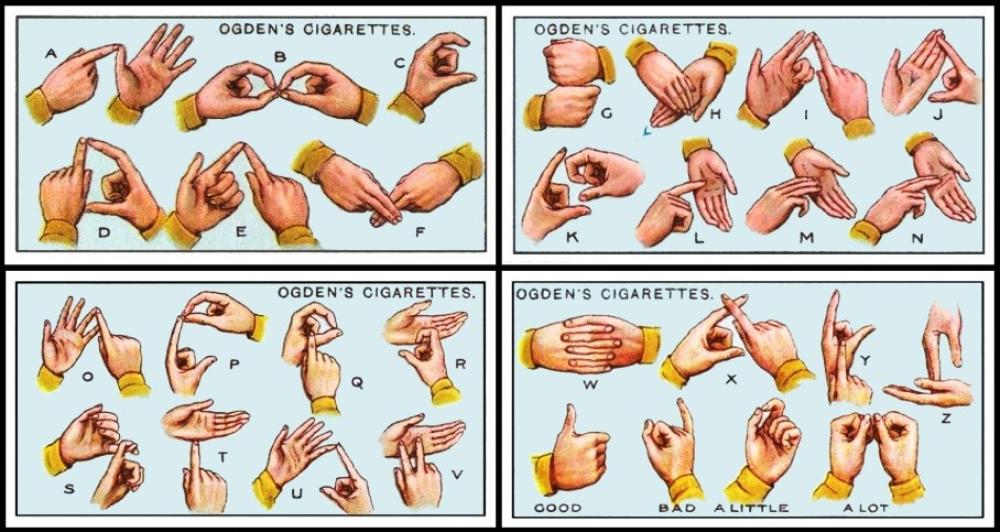
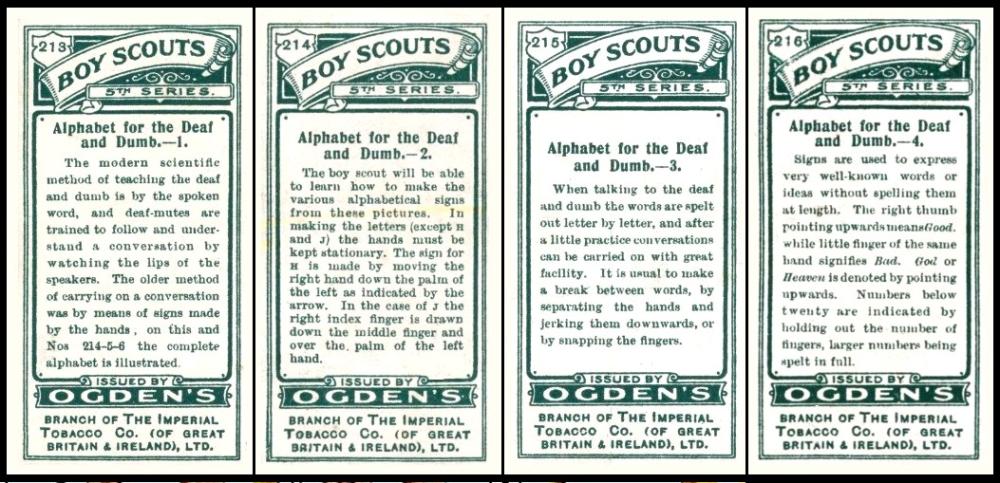
well that`s all for this week, and we hope you enjoyed your saunter through what we had to offer. Remember if there is an anniversary coming up in your collecting theme, why not send us a small section. and a scan or two. We would love to hear from you.
Take care out there, until next week, and happy collecting from us all.
